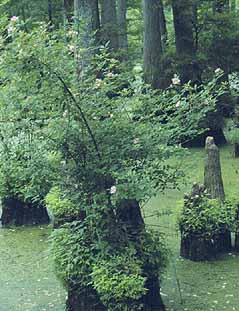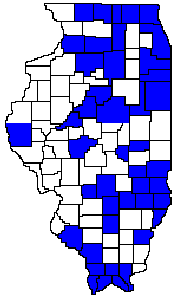 |
| Swamp
Rose (Rosa palustris)
Distribution
Map to Right |

Rosa palustris means swamp rose. It is a many-branched shrub with gracefully arching branches. It grows to heights of up to 6 feet and occurs in swamps, marshes, and along stream banks in eastern North America. Its range extends from Nova Scotia west to Minnesota, south to the Gulf of Mexico and east to Florida and the eastern coast of North America.
In Illinois, it is present in marshes in the northern parts of the state, along the major rivers and streams and ponds in the state, and in the bald cypress swamps in the southern section of the state. In the Cache River State Natural Area, swamp rose typically grows on exposed logs or even cypress knees in the swamp, taking advantage of the firm substrate.
Interesting
Facts
Swamp
rose prefers moist, acidic habitats. It prefers bogs, wet conifer swamps,
and the edges of ponds and lakes. It is a hardy rose, and it is a favorite
ornamental for low, moist, acidic spots. The cultivar (hybrid developed
for cultivation) Rosa palustris scandens is a popular rose for the
garden. Whereas the native Rosa palustris (swamp rose) has single
blooms, the cultivar has double flowers.
Swamp rose blooms in June through July and is very fragrant. It is insect pollinated, and the fleshy fruits (hips) enclose and protect the developing seeds. Birds eat the fruits and disseminate the seed.
Identifying Features
BarkUses
Swamp rose has stout, curved thorns, approximately 1/4 inch long, with a flattened base.
Leaves
The leaves are pinnately compound and the leaflets (usually 7) are oval-lance-shaped, with finely toothed edges. They are smooth on the surface and slightly hairy along the midrib underneath.
Flowers
The flowers are very fragrant. They are solitary and pink, and bloom in June-July.
Fruits
The fleshy fruits (hips) are red, up to 1/2 inch thick, and may be either smooth or covered with minute hairs.
Cultivars of swamp rose are popular ornamentals for areas that are low, wet, and acidic. Birds and other wildlife eat the fleshy swamp rose hips (fruits), and the Cherokee used an infusion (a tea) made from the bark and/or roots from swamp rose to treat worms, diarrhea, and dysentery.